Bsbinm601 Manage Knowledge and Information: Assessment and Analysis
VerifiedAdded on 2023/06/18
|24
|4689
|114
Homework Assignment
AI Summary
This assignment solution covers Bsbinm601 Manage Knowledge and Information, addressing knowledge questions related to existing and emerging technologies, statistical analysis methods for decision-making, management information systems (MIS), and decision support systems (DSS). It also includes a business analysis task focusing on Coffee Huse, involving data preparation, objective setting, and store performance analysis using time series data, trend analysis, SWOT analysis, and PESTLE analysis. The analysis identifies issues such as customer waiting times, price consistency, satisfaction levels, and declining store performance, providing insights for potential improvements. Desklib offers this and many more solved assignments for students.

Bsbinm601 manage
knowledge and
information
knowledge and
information
Paraphrase This Document
Need a fresh take? Get an instant paraphrase of this document with our AI Paraphraser

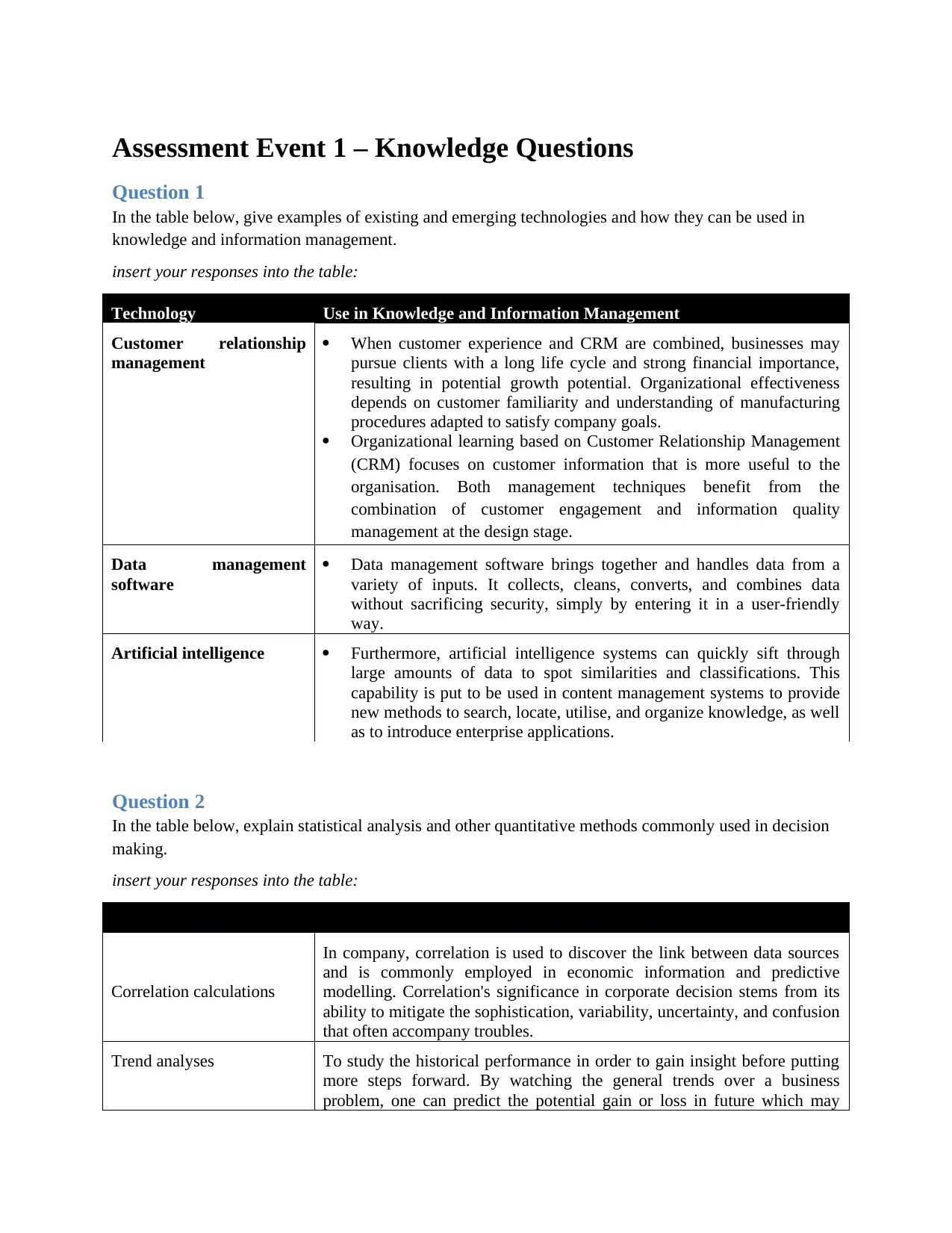
Assessment Event 1 – Knowledge Questions
Question 1
In the table below, give examples of existing and emerging technologies and how they can be used in
knowledge and information management.
insert your responses into the table:
Technology Use in Knowledge and Information Management
Customer relationship
management
When customer experience and CRM are combined, businesses may
pursue clients with a long life cycle and strong financial importance,
resulting in potential growth potential. Organizational effectiveness
depends on customer familiarity and understanding of manufacturing
procedures adapted to satisfy company goals.
Organizational learning based on Customer Relationship Management
(CRM) focuses on customer information that is more useful to the
organisation. Both management techniques benefit from the
combination of customer engagement and information quality
management at the design stage.
Data management
software
Data management software brings together and handles data from a
variety of inputs. It collects, cleans, converts, and combines data
without sacrificing security, simply by entering it in a user-friendly
way.
Artificial intelligence Furthermore, artificial intelligence systems can quickly sift through
large amounts of data to spot similarities and classifications. This
capability is put to be used in content management systems to provide
new methods to search, locate, utilise, and organize knowledge, as well
as to introduce enterprise applications.
Question 2
In the table below, explain statistical analysis and other quantitative methods commonly used in decision
making.
insert your responses into the table:
Analysis/Method How it can be used in business decision making
Correlation calculations
In company, correlation is used to discover the link between data sources
and is commonly employed in economic information and predictive
modelling. Correlation's significance in corporate decision stems from its
ability to mitigate the sophistication, variability, uncertainty, and confusion
that often accompany troubles.
Trend analyses To study the historical performance in order to gain insight before putting
more steps forward. By watching the general trends over a business
problem, one can predict the potential gain or loss in future which may
Question 1
In the table below, give examples of existing and emerging technologies and how they can be used in
knowledge and information management.
insert your responses into the table:
Technology Use in Knowledge and Information Management
Customer relationship
management
When customer experience and CRM are combined, businesses may
pursue clients with a long life cycle and strong financial importance,
resulting in potential growth potential. Organizational effectiveness
depends on customer familiarity and understanding of manufacturing
procedures adapted to satisfy company goals.
Organizational learning based on Customer Relationship Management
(CRM) focuses on customer information that is more useful to the
organisation. Both management techniques benefit from the
combination of customer engagement and information quality
management at the design stage.
Data management
software
Data management software brings together and handles data from a
variety of inputs. It collects, cleans, converts, and combines data
without sacrificing security, simply by entering it in a user-friendly
way.
Artificial intelligence Furthermore, artificial intelligence systems can quickly sift through
large amounts of data to spot similarities and classifications. This
capability is put to be used in content management systems to provide
new methods to search, locate, utilise, and organize knowledge, as well
as to introduce enterprise applications.
Question 2
In the table below, explain statistical analysis and other quantitative methods commonly used in decision
making.
insert your responses into the table:
Analysis/Method How it can be used in business decision making
Correlation calculations
In company, correlation is used to discover the link between data sources
and is commonly employed in economic information and predictive
modelling. Correlation's significance in corporate decision stems from its
ability to mitigate the sophistication, variability, uncertainty, and confusion
that often accompany troubles.
Trend analyses To study the historical performance in order to gain insight before putting
more steps forward. By watching the general trends over a business
problem, one can predict the potential gain or loss in future which may
⊘ This is a preview!⊘
Do you want full access?
Subscribe today to unlock all pages.

Trusted by 1+ million students worldwide
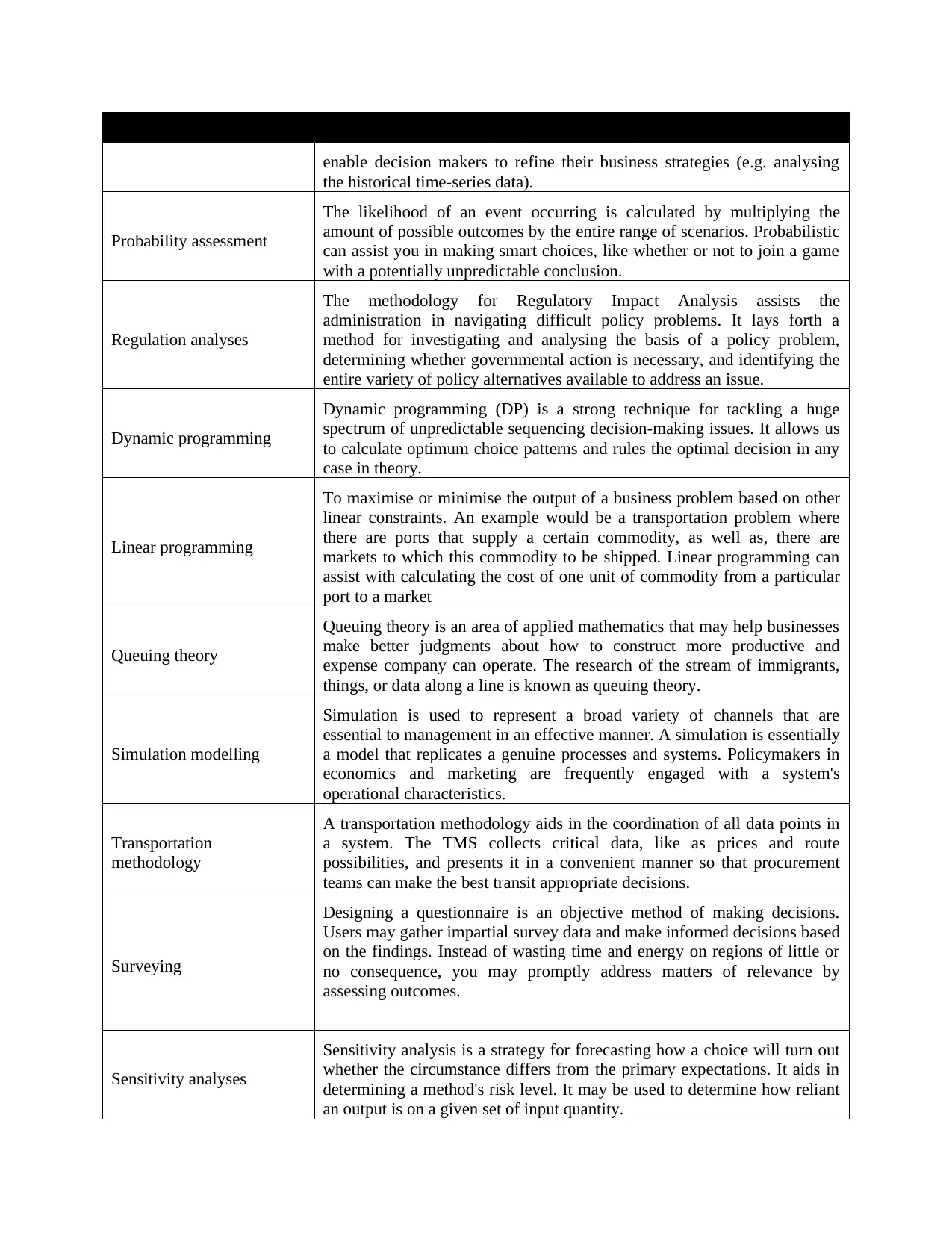
Analysis/Method How it can be used in business decision making
enable decision makers to refine their business strategies (e.g. analysing
the historical time-series data).
Probability assessment
The likelihood of an event occurring is calculated by multiplying the
amount of possible outcomes by the entire range of scenarios. Probabilistic
can assist you in making smart choices, like whether or not to join a game
with a potentially unpredictable conclusion.
Regulation analyses
The methodology for Regulatory Impact Analysis assists the
administration in navigating difficult policy problems. It lays forth a
method for investigating and analysing the basis of a policy problem,
determining whether governmental action is necessary, and identifying the
entire variety of policy alternatives available to address an issue.
Dynamic programming
Dynamic programming (DP) is a strong technique for tackling a huge
spectrum of unpredictable sequencing decision-making issues. It allows us
to calculate optimum choice patterns and rules the optimal decision in any
case in theory.
Linear programming
To maximise or minimise the output of a business problem based on other
linear constraints. An example would be a transportation problem where
there are ports that supply a certain commodity, as well as, there are
markets to which this commodity to be shipped. Linear programming can
assist with calculating the cost of one unit of commodity from a particular
port to a market
Queuing theory
Queuing theory is an area of applied mathematics that may help businesses
make better judgments about how to construct more productive and
expense company can operate. The research of the stream of immigrants,
things, or data along a line is known as queuing theory.
Simulation modelling
Simulation is used to represent a broad variety of channels that are
essential to management in an effective manner. A simulation is essentially
a model that replicates a genuine processes and systems. Policymakers in
economics and marketing are frequently engaged with a system's
operational characteristics.
Transportation
methodology
A transportation methodology aids in the coordination of all data points in
a system. The TMS collects critical data, like as prices and route
possibilities, and presents it in a convenient manner so that procurement
teams can make the best transit appropriate decisions.
Surveying
Designing a questionnaire is an objective method of making decisions.
Users may gather impartial survey data and make informed decisions based
on the findings. Instead of wasting time and energy on regions of little or
no consequence, you may promptly address matters of relevance by
assessing outcomes.
Sensitivity analyses
Sensitivity analysis is a strategy for forecasting how a choice will turn out
whether the circumstance differs from the primary expectations. It aids in
determining a method's risk level. It may be used to determine how reliant
an output is on a given set of input quantity.
enable decision makers to refine their business strategies (e.g. analysing
the historical time-series data).
Probability assessment
The likelihood of an event occurring is calculated by multiplying the
amount of possible outcomes by the entire range of scenarios. Probabilistic
can assist you in making smart choices, like whether or not to join a game
with a potentially unpredictable conclusion.
Regulation analyses
The methodology for Regulatory Impact Analysis assists the
administration in navigating difficult policy problems. It lays forth a
method for investigating and analysing the basis of a policy problem,
determining whether governmental action is necessary, and identifying the
entire variety of policy alternatives available to address an issue.
Dynamic programming
Dynamic programming (DP) is a strong technique for tackling a huge
spectrum of unpredictable sequencing decision-making issues. It allows us
to calculate optimum choice patterns and rules the optimal decision in any
case in theory.
Linear programming
To maximise or minimise the output of a business problem based on other
linear constraints. An example would be a transportation problem where
there are ports that supply a certain commodity, as well as, there are
markets to which this commodity to be shipped. Linear programming can
assist with calculating the cost of one unit of commodity from a particular
port to a market
Queuing theory
Queuing theory is an area of applied mathematics that may help businesses
make better judgments about how to construct more productive and
expense company can operate. The research of the stream of immigrants,
things, or data along a line is known as queuing theory.
Simulation modelling
Simulation is used to represent a broad variety of channels that are
essential to management in an effective manner. A simulation is essentially
a model that replicates a genuine processes and systems. Policymakers in
economics and marketing are frequently engaged with a system's
operational characteristics.
Transportation
methodology
A transportation methodology aids in the coordination of all data points in
a system. The TMS collects critical data, like as prices and route
possibilities, and presents it in a convenient manner so that procurement
teams can make the best transit appropriate decisions.
Surveying
Designing a questionnaire is an objective method of making decisions.
Users may gather impartial survey data and make informed decisions based
on the findings. Instead of wasting time and energy on regions of little or
no consequence, you may promptly address matters of relevance by
assessing outcomes.
Sensitivity analyses
Sensitivity analysis is a strategy for forecasting how a choice will turn out
whether the circumstance differs from the primary expectations. It aids in
determining a method's risk level. It may be used to determine how reliant
an output is on a given set of input quantity.
Paraphrase This Document
Need a fresh take? Get an instant paraphrase of this document with our AI Paraphraser
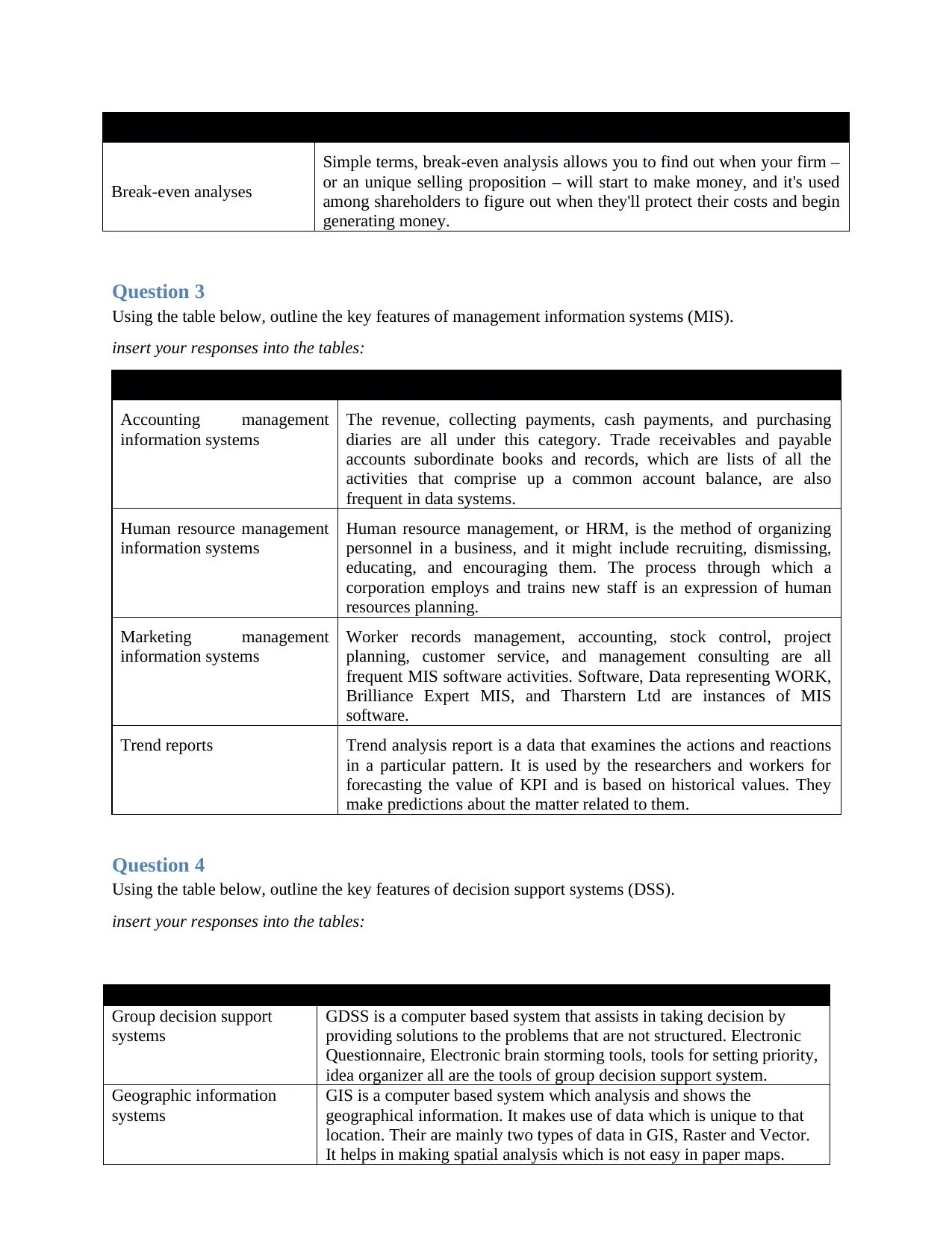
Analysis/Method How it can be used in business decision making
Break-even analyses
Simple terms, break-even analysis allows you to find out when your firm –
or an unique selling proposition – will start to make money, and it's used
among shareholders to figure out when they'll protect their costs and begin
generating money.
Question 3
Using the table below, outline the key features of management information systems (MIS).
insert your responses into the tables:
Type of MIS Example of business area
Accounting management
information systems
The revenue, collecting payments, cash payments, and purchasing
diaries are all under this category. Trade receivables and payable
accounts subordinate books and records, which are lists of all the
activities that comprise up a common account balance, are also
frequent in data systems.
Human resource management
information systems
Human resource management, or HRM, is the method of organizing
personnel in a business, and it might include recruiting, dismissing,
educating, and encouraging them. The process through which a
corporation employs and trains new staff is an expression of human
resources planning.
Marketing management
information systems
Worker records management, accounting, stock control, project
planning, customer service, and management consulting are all
frequent MIS software activities. Software, Data representing WORK,
Brilliance Expert MIS, and Tharstern Ltd are instances of MIS
software.
Trend reports Trend analysis report is a data that examines the actions and reactions
in a particular pattern. It is used by the researchers and workers for
forecasting the value of KPI and is based on historical values. They
make predictions about the matter related to them.
Question 4
Using the table below, outline the key features of decision support systems (DSS).
insert your responses into the tables:
Type of DSS Example of business area
Group decision support
systems
GDSS is a computer based system that assists in taking decision by
providing solutions to the problems that are not structured. Electronic
Questionnaire, Electronic brain storming tools, tools for setting priority,
idea organizer all are the tools of group decision support system.
Geographic information
systems
GIS is a computer based system which analysis and shows the
geographical information. It makes use of data which is unique to that
location. Their are mainly two types of data in GIS, Raster and Vector.
It helps in making spatial analysis which is not easy in paper maps.
Break-even analyses
Simple terms, break-even analysis allows you to find out when your firm –
or an unique selling proposition – will start to make money, and it's used
among shareholders to figure out when they'll protect their costs and begin
generating money.
Question 3
Using the table below, outline the key features of management information systems (MIS).
insert your responses into the tables:
Type of MIS Example of business area
Accounting management
information systems
The revenue, collecting payments, cash payments, and purchasing
diaries are all under this category. Trade receivables and payable
accounts subordinate books and records, which are lists of all the
activities that comprise up a common account balance, are also
frequent in data systems.
Human resource management
information systems
Human resource management, or HRM, is the method of organizing
personnel in a business, and it might include recruiting, dismissing,
educating, and encouraging them. The process through which a
corporation employs and trains new staff is an expression of human
resources planning.
Marketing management
information systems
Worker records management, accounting, stock control, project
planning, customer service, and management consulting are all
frequent MIS software activities. Software, Data representing WORK,
Brilliance Expert MIS, and Tharstern Ltd are instances of MIS
software.
Trend reports Trend analysis report is a data that examines the actions and reactions
in a particular pattern. It is used by the researchers and workers for
forecasting the value of KPI and is based on historical values. They
make predictions about the matter related to them.
Question 4
Using the table below, outline the key features of decision support systems (DSS).
insert your responses into the tables:
Type of DSS Example of business area
Group decision support
systems
GDSS is a computer based system that assists in taking decision by
providing solutions to the problems that are not structured. Electronic
Questionnaire, Electronic brain storming tools, tools for setting priority,
idea organizer all are the tools of group decision support system.
Geographic information
systems
GIS is a computer based system which analysis and shows the
geographical information. It makes use of data which is unique to that
location. Their are mainly two types of data in GIS, Raster and Vector.
It helps in making spatial analysis which is not easy in paper maps.
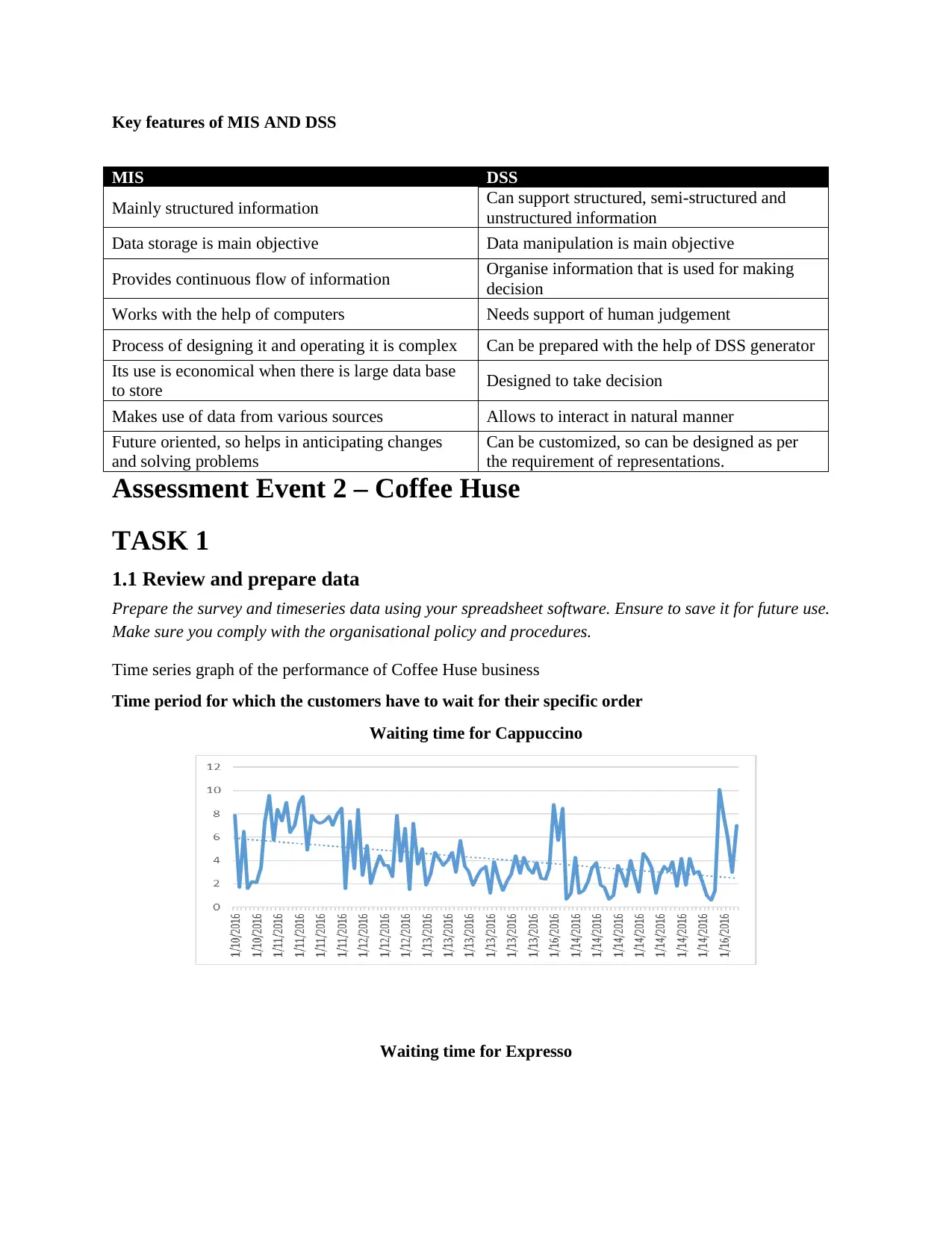
Key features of MIS AND DSS
Assessment Event 2 – Coffee Huse
TASK 1
1.1 Review and prepare data
Prepare the survey and timeseries data using your spreadsheet software. Ensure to save it for future use.
Make sure you comply with the organisational policy and procedures.
Time series graph of the performance of Coffee Huse business
Time period for which the customers have to wait for their specific order
Waiting time for Cappuccino
Waiting time for Expresso
MIS DSS
Mainly structured information Can support structured, semi-structured and
unstructured information
Data storage is main objective Data manipulation is main objective
Provides continuous flow of information Organise information that is used for making
decision
Works with the help of computers Needs support of human judgement
Process of designing it and operating it is complex Can be prepared with the help of DSS generator
Its use is economical when there is large data base
to store Designed to take decision
Makes use of data from various sources Allows to interact in natural manner
Future oriented, so helps in anticipating changes
and solving problems
Can be customized, so can be designed as per
the requirement of representations.
Assessment Event 2 – Coffee Huse
TASK 1
1.1 Review and prepare data
Prepare the survey and timeseries data using your spreadsheet software. Ensure to save it for future use.
Make sure you comply with the organisational policy and procedures.
Time series graph of the performance of Coffee Huse business
Time period for which the customers have to wait for their specific order
Waiting time for Cappuccino
Waiting time for Expresso
MIS DSS
Mainly structured information Can support structured, semi-structured and
unstructured information
Data storage is main objective Data manipulation is main objective
Provides continuous flow of information Organise information that is used for making
decision
Works with the help of computers Needs support of human judgement
Process of designing it and operating it is complex Can be prepared with the help of DSS generator
Its use is economical when there is large data base
to store Designed to take decision
Makes use of data from various sources Allows to interact in natural manner
Future oriented, so helps in anticipating changes
and solving problems
Can be customized, so can be designed as per
the requirement of representations.
⊘ This is a preview!⊘
Do you want full access?
Subscribe today to unlock all pages.

Trusted by 1+ million students worldwide
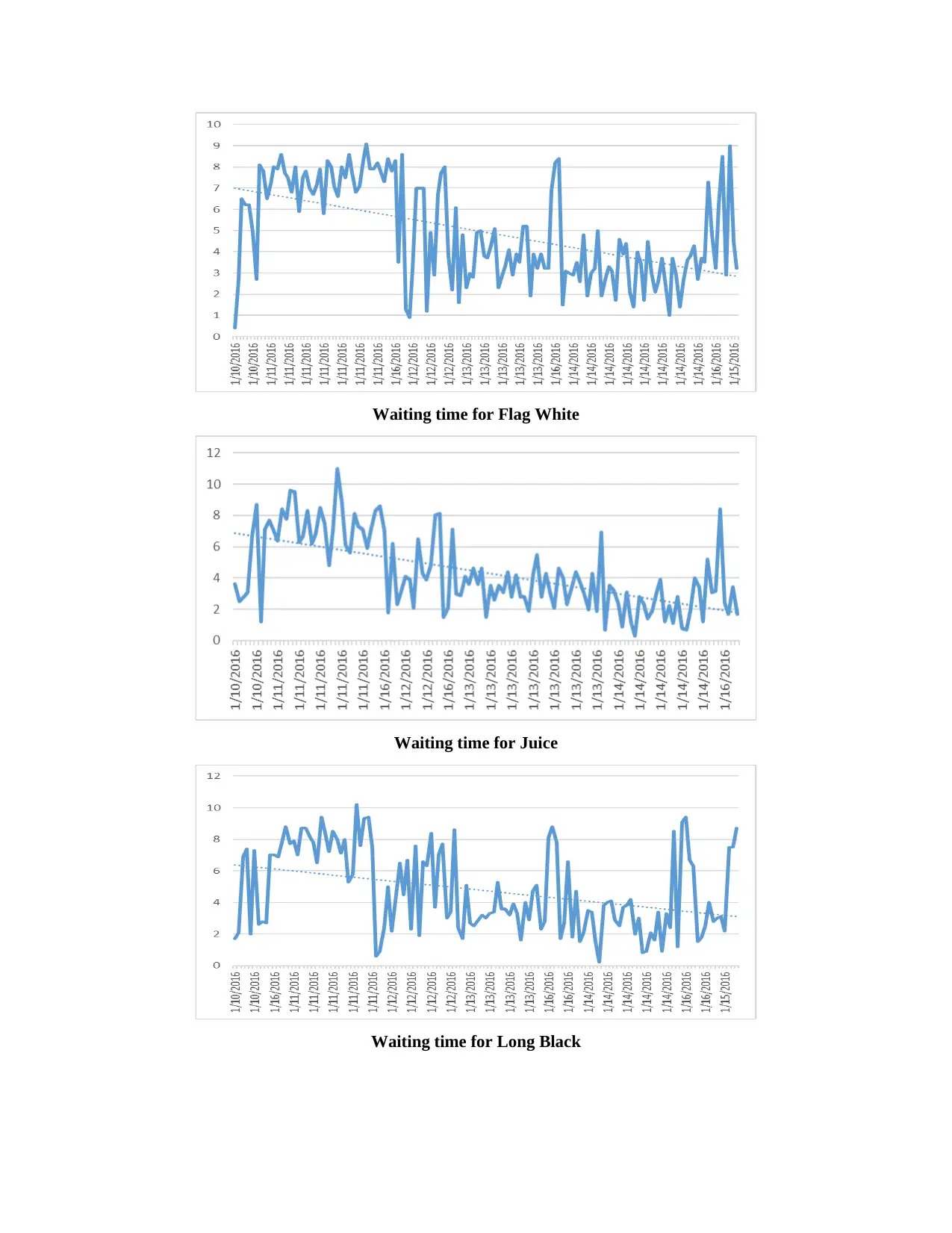
Waiting time for Flag White
Waiting time for Juice
Waiting time for Long Black
Waiting time for Juice
Waiting time for Long Black
Paraphrase This Document
Need a fresh take? Get an instant paraphrase of this document with our AI Paraphraser

Waiting time for Mocha
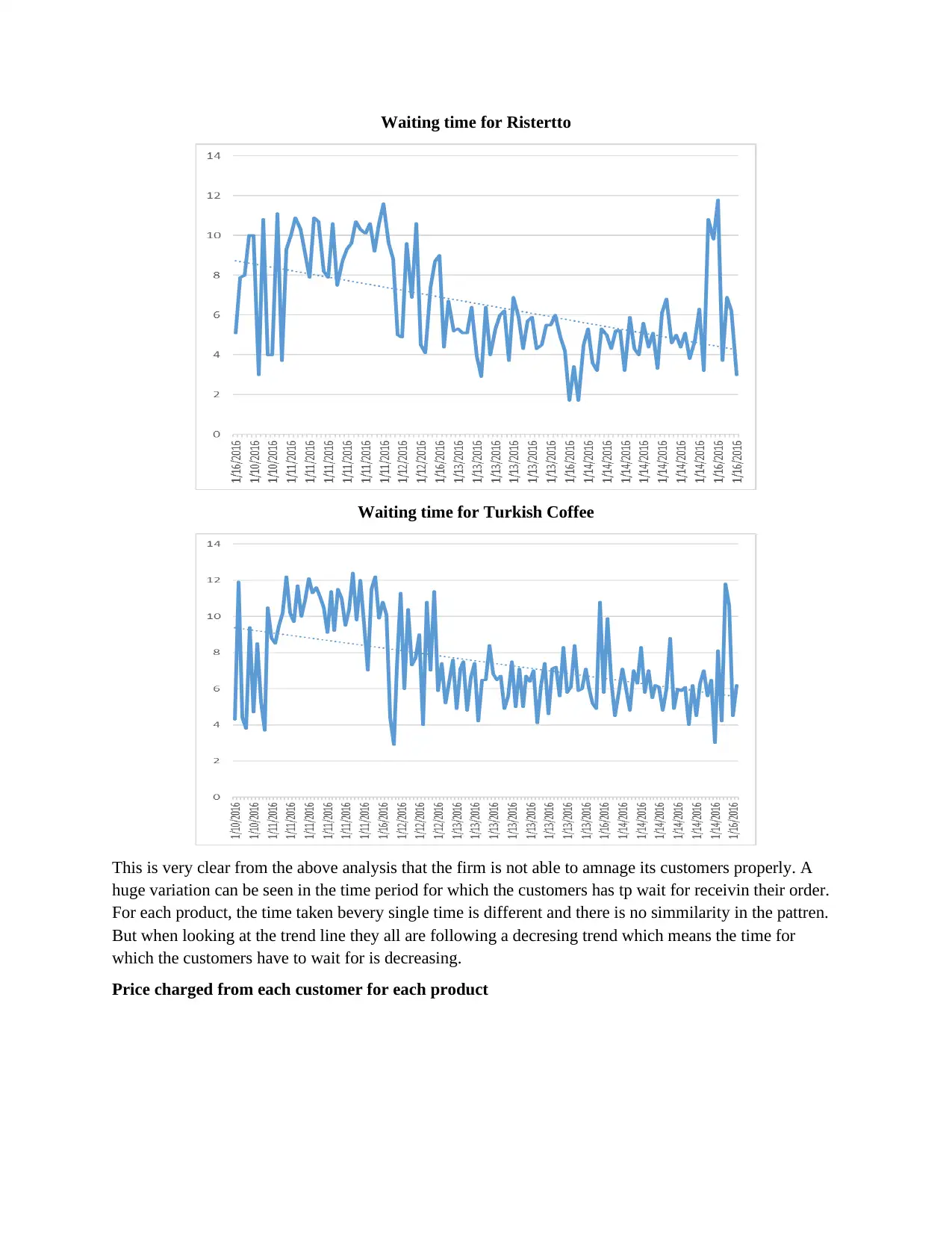
Waiting time for Ristertto
Waiting time for Turkish Coffee
This is very clear from the above analysis that the firm is not able to amnage its customers properly. A
huge variation can be seen in the time period for which the customers has tp wait for receivin their order.
For each product, the time taken bevery single time is different and there is no simmilarity in the pattren.
But when looking at the trend line they all are following a decresing trend which means the time for
which the customers have to wait for is decreasing.
Price charged from each customer for each product
Waiting time for Turkish Coffee
This is very clear from the above analysis that the firm is not able to amnage its customers properly. A
huge variation can be seen in the time period for which the customers has tp wait for receivin their order.
For each product, the time taken bevery single time is different and there is no simmilarity in the pattren.
But when looking at the trend line they all are following a decresing trend which means the time for
which the customers have to wait for is decreasing.
Price charged from each customer for each product
⊘ This is a preview!⊘
Do you want full access?
Subscribe today to unlock all pages.

Trusted by 1+ million students worldwide

Paraphrase This Document
Need a fresh take? Get an instant paraphrase of this document with our AI Paraphraser
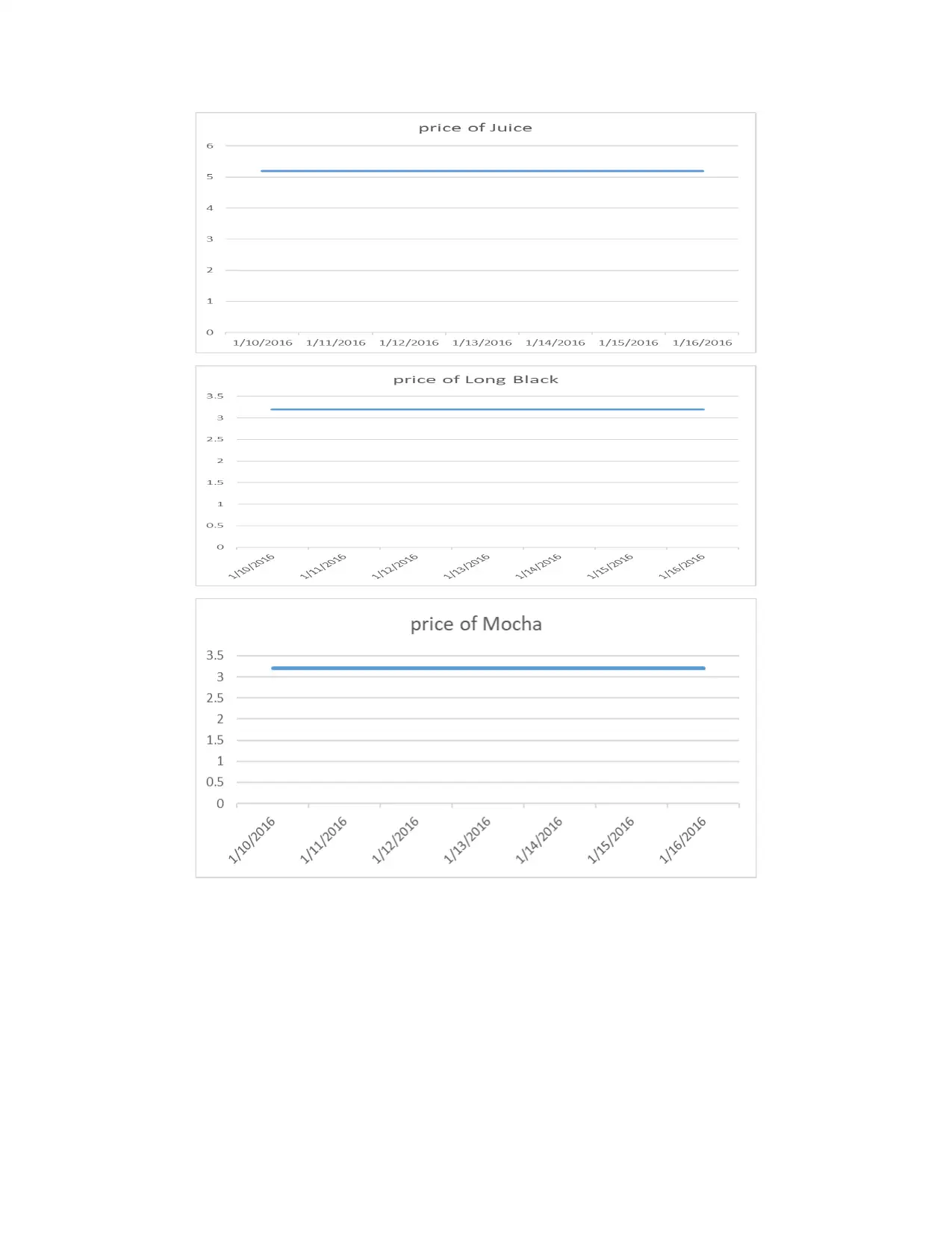
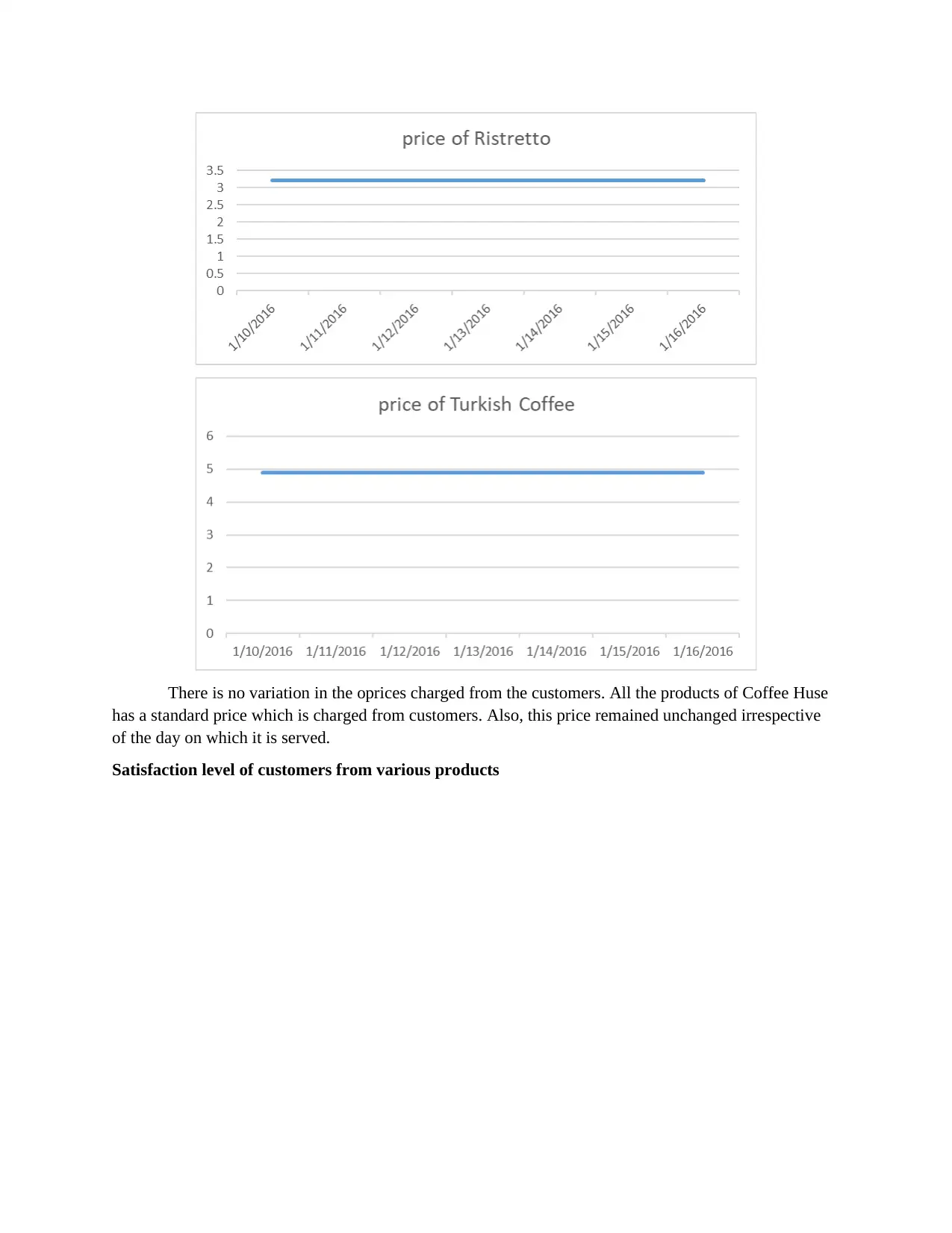
There is no variation in the oprices charged from the customers. All the products of Coffee Huse
has a standard price which is charged from customers. Also, this price remained unchanged irrespective
of the day on which it is served.
Satisfaction level of customers from various products
has a standard price which is charged from customers. Also, this price remained unchanged irrespective
of the day on which it is served.
Satisfaction level of customers from various products
⊘ This is a preview!⊘
Do you want full access?
Subscribe today to unlock all pages.

Trusted by 1+ million students worldwide
1 out of 24
Related Documents
Your All-in-One AI-Powered Toolkit for Academic Success.
+13062052269
info@desklib.com
Available 24*7 on WhatsApp / Email
![[object Object]](/_next/static/media/star-bottom.7253800d.svg)
Unlock your academic potential
Copyright © 2020–2025 A2Z Services. All Rights Reserved. Developed and managed by ZUCOL.





